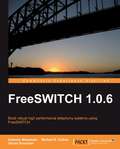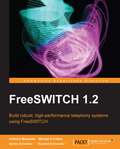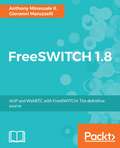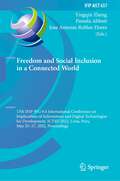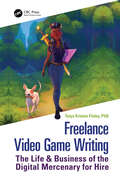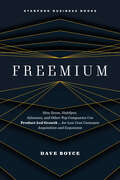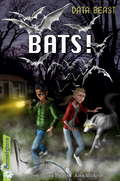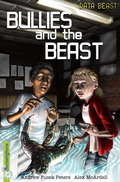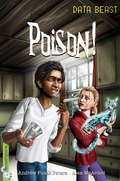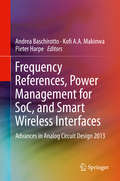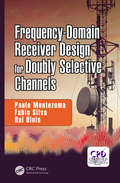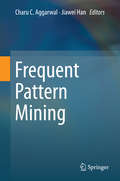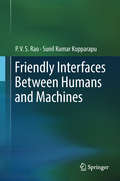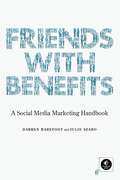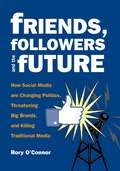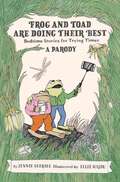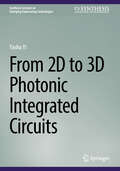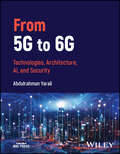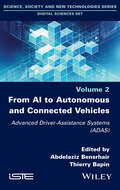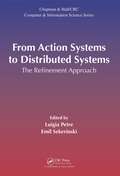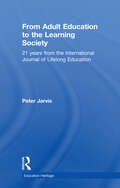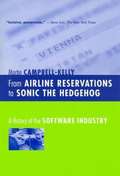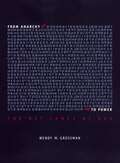- Table View
- List View
FreeSWITCH 1.0.6
by Darren Schreiber Anthony MinessaleThis book is a step-by-step tutorial with clear instructions and screenshots to guide you through the creation of a complete, cost-effective telephony system. You will start with installation, walk through the different features, and see how to manage and maintain the system. If you are an IT professional or enthusiast who is interested in quickly getting a powerful telephony system up and running using the free and open source application FreeSWITCH, this book is for you. Telephony experience will be helpful, but is not required.
FreeSWITCH 1.2
by Raymond Chandler Michael S Collins Darren Schreiber Anthony MinessaleThis book is full of practical code examples aimed at a beginner to ease his or her learning curve.This book is written for IT professionals and enthusiasts who are interested in quickly getting a powerful telephony system up and running using the free and open source application, FreeSWITCH.Telephony experience will be helpful, but not required.
FreeSWITCH 1.8
by Anthony Minessale II Giovanni MaruzzelliBuild a robust, high-performance telephony system with FreeSWITCH About This Book • Learn how to install and configure a complete telephony system of your own, from scratch, using FreeSWITCH 1.6 • Get in-depth discussions of important concepts such as dialplan, user directory, NAT handling, and the powerful FreeSWITCH event socket • Discover expert tips from the FreeSWITCH experts, including the creator of FreeSWITCH—Anthony Minessale Who This Book Is For This book is for beginner-level IT professionals and enthusiasts who are interested in quickly getting a powerful telephony system up and running using FreeSWITCH. It would be good if you have some telephony experience, but it's not a must. What You Will Learn • Build a complete WebRTC/SIP VoIP platform able to interconnect and process audio and video in real time • Use advanced PBX features to create powerful dialplans • Understand the inner workings and architecture of FreeSWITCH • Real time configuration from database and webserver with mod_xml_curl • Integrate browser clients into your telephony service • Use scripting to go beyond the dialplan with the power and flexibility of a programming language • Secure your FreeSWITCH connections with the help of effective techniques • Deploy all FreeSWITCH features using best practices and expert tips • Overcome frustrating NAT issues • Control FreeSWITCH remotely with the all-powerful event socket • Trace packets, check debug logging, ask for community and commercial help In Detail FreeSWITCH is an open source telephony platform designed to facilitate the creation of voice and chat-driven products, scaling from a soft-phone to a PBX and even up to an enterprise-class soft-switch. This book introduces FreeSWITCH to IT professionals who want to build their own telephony system. This book starts with a brief introduction to the latest version of FreeSWITCH. We then move on to the fundamentals and the new features added in version 1.6, showing you how to set up a basic system so you can make and receive phone calls, make calls between extensions, and utilize basic PBX functionality. Once you have a basic system in place, we'll show you how to add more and more functionalities to it. You'll learn to deploy the features on the system using unique techniques and tips to make it work better. Also, there are changes in the security-related components, which will affect the content in the book, so we will make that intact with the latest version. There are new support libraries introduced, such as SQLite, OpenSS, and more, which will make FreeSWITCH more efficient and add more functions to it. We'll cover these in the new edition to make it more appealing for you. Style and approach This easy-to-follow guide helps you understand every topic easily using real-world examples of FreeSWITCH tasks. This book is full of practical code so you get a gradual learning curve.
FreeSWITCH Cookbook
by Raymond Chandler Darren Schreiber Anthony Minessale Michael S. CollinsThis is a problem-solution approach to take your FreeSWITCH skills to the next level, where everything is explained in a practical way. If you are a system administrator, hobbyist, or someone who uses FreeSWITCH on a regular basis, this book is for you. Whether you are a FreeSWITCH expert or just getting started, this book will take your skills to the next level.
Freedom and Social Inclusion in a Connected World: 17th IFIP WG 9.4 International Conference on Implications of Information and Digital Technologies for Development, ICT4D 2022, Lima, Peru, May 25–27, 2022, Proceedings (IFIP Advances in Information and Communication Technology #657)
by Pamela Abbott Yingqin Zheng Jose Antonio Robles-FloresThis book constitutes the refereed proceedings of the 17th IFIP WG 9.4 International Conference on Social Implications of Computers in Developing Countries, ICT4D 2022, which was supposed to be held in Lima, Peru, in May 2021, but was held virtually instead due to the COVID-19 pandemic.The 40 revised full papers presented were carefully reviewed and selected from 58 submissions. The papers present a wide range of perspectives and disciplines including (but not limited to) public administration, entrepreneurship, business administration, information technology for development, information management systems, organization studies, philosophy, and management. They are organized in the following topical sections: digital platforms and gig economy; education and health; inclusion and participation; and business innovation and data privacy.
Freelance Video Game Writing: The Life & Business of the Digital Mercenary for Hire
by Toiya Kristen FinleyIn the competitive world of video game writing and narrative design, developers are losing permanent positions while freelancing careers are on the rise. Many developers don’t understand how to seize these freelancing opportunities, such as understanding the business of freelancing, how to go about finding work, how to establish strong relationships with clients, and how to sustain themselves as freelancers. Freelance Video Game Writing: The Life & Business of the Digital Mercenary for Hire offers developers guidance on achieving their freelancing goals as telecommuters. Dr. Toiya Kristen Finley presents practical insight into the profession and how to further enhance your freelancing business, whether you are a newcomer in the field or an experienced freelancer. Key Features: Two sections covering the life of the freelancer and the freelance business Fifteen interviews from narrative designers, game writers, and other developers on topics from maintaining a healthy work–life balance to figuring out your rates to working a full-time job and freelancing on the side A comprehensive list of definitions with which freelancers need to be familiar Exercises to help augment your understanding of freelancing and improve your business Biography Nashville native Toiya Kristen Finley, PhD, has been a freelance writer and editor her entire adult life. She earned a doctorate in literature and creative writing from Binghamton University. Over her career, she has published more than 80 works of fiction, nonfiction, comics/manga, and games, and has over 20 years of experience writing in a range of genres, tones, styles, and voices. She gained editorial experience interning at Henry Holt’s imprint, Owl Books. At Binghamton, she founded the literary journal Harpur Palate and served as its managing/fiction editor. In 2011, she cofounded the Game Writing Tutorial at GDC Online with Tobias Heussner and served as an instructor in 2011 and 2012. In videogames, she has worked as a game designer, narrative designer, game writer, editor, and diversity/narrative consultant (or some combination of the five) on everything from AAA titles to mobile games to games for children to small indie projects. Recent work includes writing the visual novel Siren Song (Stardust Works), copyediting for Destiny 2 (Bungie), and developmental editing on Insecure: The Come Up Game (Glow Up Games). A presenter at conferences throughout the year, she has lectured on freelancing and storytelling and led workshops on narrative design and game design. She is a member of the IGDA Game Writing Special Interest Group’s Executive Board. The Game Narrative Toolbox (CRC Press), a book on narrative design she coauthored with Jennifer Brandes Hepler, Ann Lemay, and Tobias Heussner, was published in 2015. Narrative Tactics for Mobile and Social Games: Pocket-Sized Storytelling (CRC Press), which she edited and contributed to, was published in 2019. Of late, she has been working on her own visual novel series, beginning with Incarnō: Everything Is Written.
Freemium: How Zoom, HubSpot, Atlassian, and Other Top Companies Use Product-Led Growth … for Low-Cost Customer Acquisition and Expansion
by Dave BoyceA Next Big Idea Club "Must Read" for August 2025! Competing in tech today requires an understanding of "product-led growth" Companies like Dropbox, Zoom, Slack, Atlassian, and DocuSign grew into multibillion-dollar companies using the 3-step "Freemium" product strategy: (1) instead of hiring an expensive sales force, give away software for free; (2) let happy users tell others; (3) offer a premium subscription version, producing a recurring revenue stream. Over the last three decades, Freemium strategy has evolved into a practice known to tech industry insiders as "product-led growth," which Harvard Business School Lecturer Frank Cespedes calls, "probably the fastest-growing go-to-market model for businesses globally." Freemium is the authoritative guide to product-led growth, written by Silicon Valley entrepreneur and Harvard MBA Dave Boyce, who teaches the first MBA-level course on the topic. Freemium explains how to develop a product that can sell itself, how to ward off competitors, and how to seamlessly move upmarket, selling to larger customers. It details how the product itself (instead of expensive employees) can be used for customer onboarding, customer service, and customer retention. Freemium also details how non-software companies and enterprise sales-led companies are combining product-led growth tactics with more traditional go-to-market initiatives. Competing in nearly every tech-related industry today requires an understanding of the principles of product-led growth. Freemium is the comprehensive, practical handbook for this unicorn-building strategy.
Freestylers Data Beast: Bats! (Freestylers: Data Beast)
by Andrew Fusek PetersA short thriller that's high on suspense! This is a perfect page turner if you want to finish a story in one sitting, especially for reluctant and struggling readers. Cool, edgy computer hackers, Kiran and Ros are teens who set out to fight crime and injustice with the help of a shape-shifting data beast they've created. In Bats!, Kiran and Ros take on a firm of developers who are planning to build a shopping mall next to their school, tearing down a local habitat for endangered bats in the process. Can the data beast reveal the dodgy dealings going on behind the scenes and stop the environmental vandalism before it's too late? Reading level for this book:- ATOS: 2.6 Lexile ® Measure: 360L Book Band: 11 Lime
Freestylers Data Beast: Bullies and the Beast (Freestylers: Data Beast)
by Andrew Fusek PetersA short thriller that's high on suspense! This is a perfect page turner if you want to finish a story in one sitting, especially for reluctant and struggling readers. Cool, edgy computer hackers, Kiran and Roz are teens who set out to fight crime and injustice with the help of a shape-shifting data beast they've created. In Bully and the Beast, Kiran and Roz first encounter the data beast as it emerges from their computer. Initially terrified of it, they become friends with the beast and see it become more than a match for the bullies that are terrorising their school. Reading level for this book:- ATOS: 2.7 Lexile ® Measure: 360L Book Band: White
Freestylers Data Beast: Monster Savings (Freestylers: Data Beast)
by Andrew Fusek PetersA short thriller that's high on suspense! This is a perfect page turner if you want to finish a story in one sitting, especially for reluctant and struggling readers. Cool, edgy computer hackers, Kiran and Roz are teens who set out to fight crime and injustice with the help of a shape-shifting data beast they've created. In Monster Savings, Kiran and Roz take on the might of shopping phenomenon everythingonearth.com, a company that sells anything to anyone, but evades tax and avoids giving its workers fair pay and conditions. It's the data beast's most perilous mission yet - will it survive? Reading level for this book:- ATOS: 2.6 Lexile ® Measure: 360L Book Band: 11 Lime
Freestylers Data Beast: Poison! (Freestylers: Data Beast)
by Andrew Fusek PetersA short thriller that's high on suspense! This is a perfect page turner if you want to finish a story in one sitting, especially for reluctant and struggling readers. Cool, edgy computer hackers, Kiran and Ros are teens on a mission to fight crime and injustice with the help of a shape-shifting data beast they've created. In Poison!, Kiran and Roz set out to prove that a chemical company is polluting the river near their school and the poisoning the fish that live in it. With the help of the data beast they attempt to bring the murky activities into the light - and the beast goes on a dangerous mission to save the threatened fish. Reading level for this book:- ATOS: 2.6 Lexile ® Measure: 360L Book Band: 11 Lime
Frequency References, Power Management for SoC, and Smart Wireless Interfaces
by Andrea Baschirotto Kofi A.A. Makinwa Pieter HarpeThis book is based on the 18 tutorials presented during the 22nd workshop on Advances in Analog Circuit Design. Expert designers present readers with information about a variety of topics at the frontier of analog circuit design, including frequency reference, power management for systems-on-chip, and smart wireless interfaces. This book serves as a valuable reference to the state-of-the-art, for anyone involved in analog circuit research and development.
Frequency-Domain Receiver Design for Doubly Selective Channels
by Fabio Silva Paulo Montezuma Rui DinisFrequency-Domain Receiver Design for Doubly-Selective Channels discusses broadband wireless transmission techniques, which are serious candidates to be implemented in future broadband wireless and cellular systems, aiming at providing high and reliable data transmission and concomitantly high mobility. This book provides an overview of the channel impairments that may affect performance of single carrier and multi-carrier block transmission techniques in mobile environments. Moreover, it also provides a new insight into the new receiver designs able to cope with double selectivity that affects present and future broadband high speed mobile communication systems.
Frequent Pattern Mining
by Jiawei Han Charu C. AggarwalThis comprehensive reference consists of 18 chapters from prominent researchers in the field. Each chapter is self-contained, and synthesizes one aspect of frequent pattern mining. An emphasis is placed on simplifying the content, so that students and practitioners can benefit from the book. Each chapter contains a survey describing key research on the topic, a case study and future directions. Key topics include: Pattern Growth Methods, Frequent Pattern Mining in Data Streams, Mining Graph Patterns, Big Data Frequent Pattern Mining, Algorithms for Data Clustering and more. Advanced-level students in computer science, researchers and practitioners from industry will find this book an invaluable reference.
Friendly Interfaces Between Humans and Machines
by Sunil Kumar Kopparapu P. V. RaoThis book discusses human–machine interactions, specifically focusing on making them as natural as human–human interaction. It is based on the premise that to get the right connect between human and machines, it is essential to understand not only the behavior of the person interacting with the machine, but also the limitations of the technology. Firstly, the authors review the evolution of language as a spontaneous, natural phenomenon in the overall scheme of the evolutionary development of living beings. They then go on to examine the possible approaches to understanding and representing the meaning and the common aspects of human–human and human–machine interactions, and introduce the keyconcept-keyword (also called minimal parsing) approach as a convenient and realistic way to implement usable human–machine interface (HMI) systems. For researchers looking for practical approaches, way beyond the realms of theory, this book is a must read.
Friends with Benefits: A Social Media Marketing Handbook
by Darren Barefoot Julie Szabo<P>The rules of marketing have changed. Savvy marketing professionals know that they must engage with individuals directly on the Web, and smart businesses know that customers can become friends—with benefits. Friends With Benefits shows you how to get into the online marketing game. A guide filled with tips, tricks, and real-world case studies, Friends With Benefits shows how you can increase your company's online visibility and Web traffic and win over online influencers. <P>Friends With Benefits explains how to: <br>–Connect with potential customers and join their conversations <br>–Tweak your website to support your social media marketing campaigns <br>–Promote your products or brand and manage the toughest negative online feedback <br>–Track marketing campaigns, monitor discussions, and measure success <P>With viral videos racking up millions of views and Twitter mavens influencing thousands of their friends, social media marketing is an essential new tool for every marketer's toolbox. The expert authors of Friend With Benefits guide you through the social media landscape, where authenticity and connections are more important than the size of your marketing budget, and real results can be just a few clicks away.
Friends, Followers and the Future
by Rory O'Connor"Rory O'Connor is one of the smartest media guys around. He knows who's spinning, who's pandering, and who's putting money in his own pocket at the expense of logic, reason, and the public good."-Michael Wolff, Vanity Fair media criticThere's a revolution going on, as ever-accelerating developments in digital information technologies change nearly every aspect of how we live, work, play, do business, and engage in politics. Share and share alike-the numbers say it all as billions of people worldwide flock to online media and use social networks to discover and spread news and information.In the process, ever-growing networks of "ordinary people" are using these powerful new tools to trim the influence long held by Big Business, Big Government, and Big Media. No longer just passive recipients, participants in social networks now regularly make and break news while organizing civic and political actions that bypass censors, outpace traditional media, attract massive audiences, and influence the rise and fall of brands, industries, politicians, and even governments.In this insider's look at how social media are transforming our world, Rory O'Connor explains the trends and explores what tech visionaries, media makers, political advisers, and businesspeople are saying about the meteoric rise of the various social networks of friends and followers, and what they bode for our future.Rory O'Connor, co-founder of MediaChannel.org, is the author of Shock Jocks: Hate Speech & Talk Radio. He has won two Emmys and a George Orwell Award, among many other honors.
Frog and Toad are Doing Their Best [A Parody]: Bedtime Stories for Trying Times
by Jennie EgerdieAt home, work, and out in our ever-changing world, we're all just doing our best. In this modern parody, Frog and Toad are here to commiserate and lend some laughter.Full of wry humor and deep compassion for our modern vulnerabilities, the stories in Frog and Toad Are Doing Their Best perfectly capture the heartwarming authenticity of Lobel&’s famous amphibian friends while revealing razor-sharp truths about the world we live in today. Through Frog and Toad, we see the anxieties that are woven throughout our everyday existence, from our well-meaning but often-failed attempts at practicing self-care to our struggle to balance the gifts and burdens of technology. Toad ponders a variety of questionable schemes to pay off his credit cards, while Frog spends too much time scrolling through the newsfeed on his phone. But despite their daily frustrations and existential concerns, they know that having a friend to share life&’s burdens makes even the darkest days brighter.
From 2D to 3D Photonic Integrated Circuits (Synthesis Lectures on Emerging Engineering Technologies)
by Yasha YiThe integration of photonics and electronics has transformed the landscape of modern technology. At the forefront of this revolution is the development of Photonic Integrated Circuits (PICs). Historically rooted in the traditional 2-D fabrication processes inherited from electronic Integrated Circuits, PICs shifted to 3-D configurations, introducing new design philosophies that impact scalability, efficiency, and performance. This convergence of electronic and photonic circuits presents unique challenges and great opportunities. This book provides an introduction to photonic integrated circuits and the transition from 2D to 3D PICs. It then describes design and fabrication techniques of 3D PICs and related challenges and solutions. Finally, applications of 3D photonics, emerging technologies and industry outlook are also discussed.
From 5G to 6G: Technologies, Architecture, AI, and Security
by Abdulrahman YaraliFrom 5G to 6G Understand the transition to the sixth generation of wireless with this bold introduction The transition from the fifth generation of wireless communication (5G) to the coming sixth generation (6G) promises to be one of the most significant phases in the history of telecommunications. The technological, social, and logistical challenges promise to be significant, and meeting these challenges will determine the future of wireless communication. Experts and professionals across dozens of fields and industries are beginning to reckon seriously with these challenges as the 6G revolution approaches. From 5G to 6G provides an overview of this transition, offering a snapshot of a moment in which 5G is establishing itself and 6G draws ever nearer. It focuses on recent advances in wireless technology that brings 6G closer to reality, as well as the near-term challenges that still have to be met for this transition to succeed. The result is an essential book for anyone wishing to understand the future of wireless telecommunications in an increasingly connected world. From 5G to 6G readers will also find: 6G applications to both AI and Machine Learning, technologies which loom ever larger in wireless communication Discussion of subjects including smart healthcare, cybersecurity, extended reality, and more Treatment of the ongoing infrastructural and technological requirements for 6G From 5G to 6G is essential for researchers and academics in wireless communication and computer science, as well as for undergraduates in related subjects and professionals in wireless-adjacent fields.
From AI to Autonomous and Connected Vehicles: Advanced Driver-Assistance Systems (ADAS)
by Abdelaziz Bensrhair Thierry BapinThe main topic of this book is the recent development of on-board advanced driver-assistance systems (ADAS), which we can already tell will eventually contribute to the autonomous and connected vehicles of tomorrow.With the development of automated mobility, it becomes necessary to design a series of modules which, from the data produced by on-board or remote information sources, will enable the construction of a completely automated driving system. These modules are perception, decision and action. State-of-the-art AI techniques and their potential applications in the field of autonomous vehicles are described.Perception systems, focusing on visual sensors, the decision module and the prototyping, testing and evaluation of ADAS systems are all presented for effective implementation on autonomous and connected vehicles.This book also addresses cooperative systems, such as pedestrian detection, as well as the legal issues in the use of autonomous vehicles in open environments.
From Action Systems to Distributed Systems: The Refinement Approach
by Emil Sekerinski Luigia PetreFormal methods traditionally address the question of transforming software engineering into a mature engineering discipline. This essentially refers to trusting that the software-intensive systems that form our society's infrastructures are behaving according to their specifications. More recently, formal methods are also used to understand propert
From Adult Education to the Learning Society: 21 Years of the International Journal of Lifelong Education (Education Heritage)
by Peter JarvisThis unique text provides a valuable route map to the development of thinking in adult education and lifelong learning. It includes more than twenty-five seminal articles from the first two decades of the International Journal of Lifelong Education, written by leading authors in the field from the UK, the USA, Australia and Europe. Compiled to show the development of the field, the articles are divided into four sections: From Ault Education… …to Lifelong Education …and Lifelong Learning …to the Learning Society and Beyond. The specially written Introduction by the editor contextualises the selection and introduces readers to the main issues and current thinking in the field. This is the only text of its kind to demonstrate practice and policy internationally over this period, and as the collection of articles are now available in one easy-access place, this is an excellent resource for students and scholars.
From Airline Reservations to Sonic the Hedgehog: A History of the Software Industry
by Martin Campbell-KellyFrom its first glimmerings in the 1950s, the software industry has evolved to become the fourth largest industrial sector of the US economy. Starting with a handful of software contractors who produced specialized programs for the few existing machines, the industry grew to include producers of corporate software packages and then makers of mass-market products and recreational software. This book tells the story of each of these types of firm, focusing on the products they developed, the business models they followed, and the markets they served. By describing the breadth of this industry, Martin Campbell-Kelly corrects the popular misconception that one firm is at the center of the software universe. He also tells the story of lucrative software products such as IBM's CICS and SAP's R/3, which, though little known to the general public, lie at the heart of today's information infrastructure. With its wealth of industry data and its thoughtful judgments, this book will become a starting point for all future investigations of this fundamental component of computer history.
From Anarchy to Power: The Net Comes of Age
by Wendy GrossmanYesterday's battles over internet turf were fought on the net itself: today's battles are fought in government committees, in Congress, on the stock exchange, and in the marketplace. What was once an experimental ground for electronic commerce is now the hottest part of our economic infrastructure. In From Anarchy to Power, Wendy Grossman explores the new dispensation on the net and tackles the questions that trouble every online user: How vulnerable are the internet and world wide web to malicious cyber hackers? What are the limits of privacy online? How real is internet addiction and to what extent is the news media responsible for this phenomenon? Are women and minorities at a disadvantage in cyberspace? How is the increasing power of big business changing internet culture? We learn about the political economy of the internet including issues of copyright law, corporate control and cryptography legislation. Throughout the book the emphasis is on the international dimensions of the net, focusing on privacy and censorship in the United States, Europe and Canada and the hitherto ignored contributions of other countries in the development of the net. Entertaining and informative From Anarchy to Power is required reading for anyone who wants to know where the new digital economy is heading.
